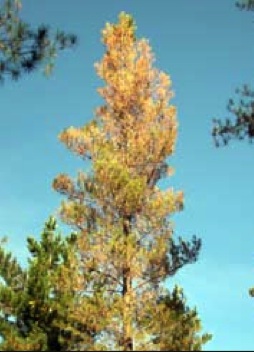PESTS AND DISEASES OF FORESTRY IN NEW ZEALAND
The Monterey pine aphid in New Zealand
Scion is the leading provider of forest-related knowledge in New Zealand
Formerly known as the Forest Research Institute, Scion has been a leader in research relating to forest health for over 50 years. The Rotorua-based Crown Research Institute continues to provide science that will protect all forests from damage caused by insect pests, pathogens and weeds. The information presented below arises from these research activities.
Forest Health News 182, March 2008.
The Monterey pine aphid, Essigella californica, has been the subject of recent studies in New Zealand and Australia. It is native to western North America and Mexico where it feeds on Pinaceae, primarily Pinus, and occasionally on Pseudotsuga species. It was first recorded outside the USA in 1989 in France, where it caused localised damage and needle yellowing. The aphid has since become established in Spain, southern Brazil, Australia, and New Zealand. It was first detected in Australia and New Zealand in
1998 and found to be widespread in these countries.
In New Zealand, the impact of E. californica is largely unknown. Large numbers of this aphid have been recorded on particular Pinus radiata trees in some years but there are few records of damage on these trees.

A climate model of E. californica had predicted excessive rainfall might limit aphid numbers, and the comparatively high numbers of E. californica recorded at favourable sites in Australia suggest the New Zealand climate is generally less favourable for the aphid.
In Australia, E. californica has been associated with upper crown yellowing and premature needle shed in P. radiata forests, but a causal relationship has been difficult to demonstrate. Defoliation typically occurs between early autumn and late winter. Damage has been most severe in south-eastern Australia, particularly in stands older than 15 years. Defoliation associated with E. californica has been estimated to have reduced productivity of P. radiata plantings in this area by A$21 million per year.
To investigate further the potential impact of this pest in New Zealand, Scion has been monitoring E. californica abundance on P. radiata at two climatically contrasting forests — Kaingaroa Forest in the Bay of Plenty and McLeans Island in Canterbury — for the past 2 years. The beat method was used to sample aphid numbers, which peak in autumn from March to May. Significantly more E. californica were recorded in autumn 2006 than 2007, and at the Canterbury site in both years. No leaf yellowing associated with E. californica was recorded at either site, suggesting that it may not be a problem for New Zealand forest growers. Monitoring has begun
this autumn, with unexpectedly low numbers recorded so far.
The higher numbers of aphids collected at the Canterbury site, which is much drier and has higher average summer and autumn temperatures than the Bay of Plenty forest, validate the climate model predictions.
Michelle Watson
This information is intended for general interest only. It is not intended to be a substitute for specific specialist advice on any matter and should not be relied on for that purpose. Scion will not be liable for any direct, indirect, incidental, special, consequential or exemplary damages, loss of profits, or any other intangible losses that result from using the information provided on this site.
(Scion is the trading name of the New Zealand Forest Research Institute Limited.)



